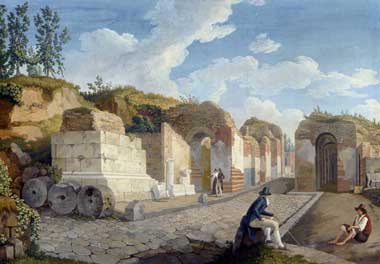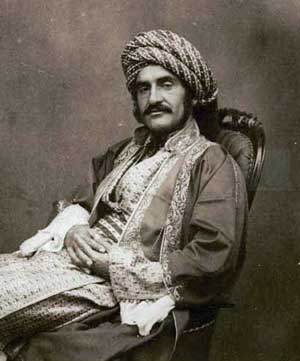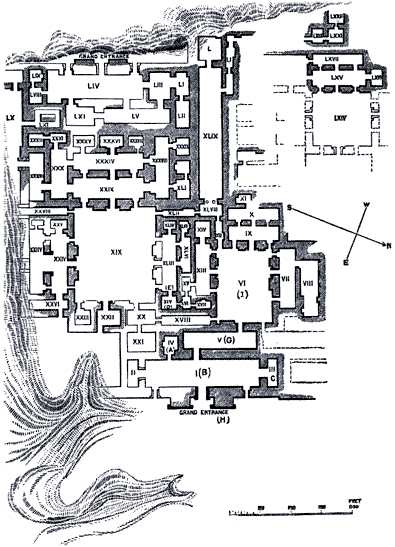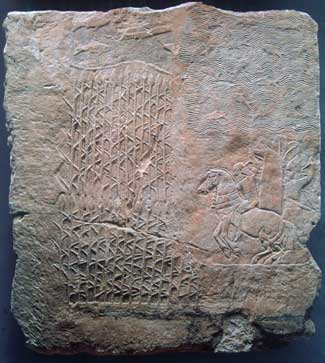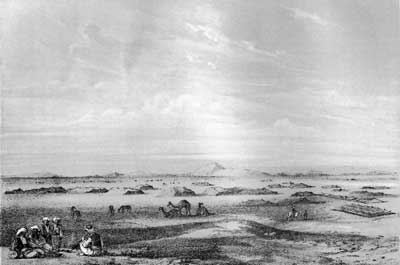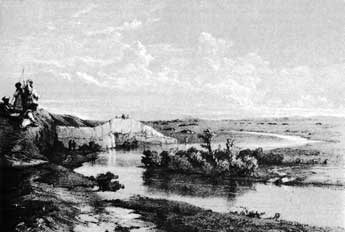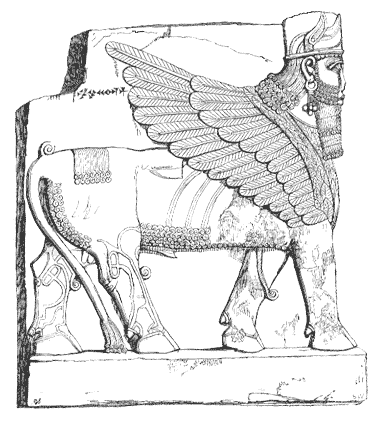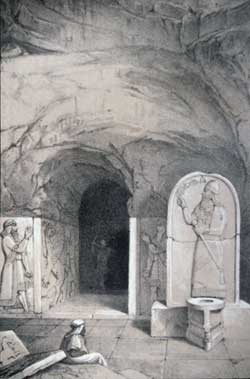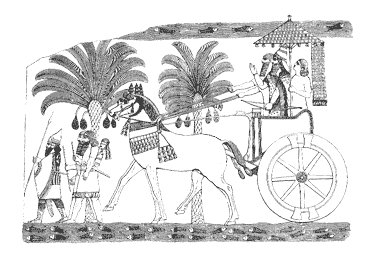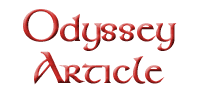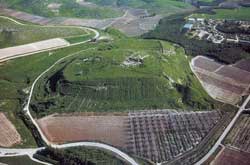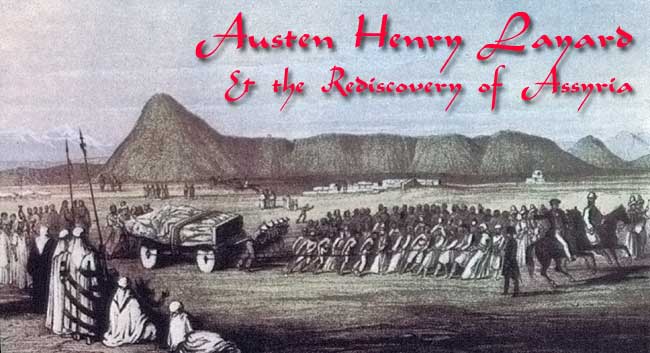
Nineveh
Layard's Triumph
Layard's return to Europe was somewhat overshadowed by the Revolutions which broke out throughout Europe in 1848. He was informed of a pending offer of a permanent post with the Foreign Office and instructed to wait in Istanbul where he cooled his heels for a while, waiting for Canning, but he came down with malaria and steamed for Italy that autumn, where he visited old friends and toured the ruins of Pompeii before heading to Paris. Botta greeted him with open arms and he was invited to address the Académie des Inscriptions et Belles Lettres where he was very warmly received and congratulated on his work. As for Botta himself, he had fully expected to be back in Mosul as French Consul by now but political developments in France prevented this. As it happened, within a few months King Louis-Philippe was a refugee and there was a Republic once again in France and Botta was banished to a minor post at Jerusalem—the two men never met again.
Pressing on to London, Layard arrived at his uncle's house on Montague Square in December 1847 and soon made contact with his employers at the British Museum. The first consignments from Nimrud had already arrived and the objects were on display—although there were crates still on the quayside at Basra. For the time being, he needed to rest and recover from the exhaustion and recurrent bouts of malaria, which had greatly weakened him. The Foreign Office had at last found a position for him—as member of an international boundary commission to settle the frontier between Turkey and Persia. He was not exactly keen to head back to the Near East so soon after his arrival home—he was enjoying his new-found fame and the round of dinners and parties it brought. Arrangements were made to publish his drawings and copies of the texts along with a 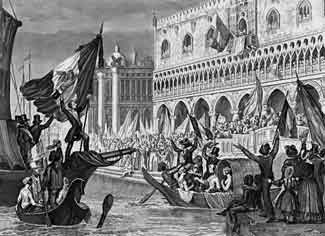 popular account of his excavations but the Museum was not keen to provide funds for further excavations. Layard wanted £4000-5000 for the first year alone—totally unrealistic under the circumstances.
popular account of his excavations but the Museum was not keen to provide funds for further excavations. Layard wanted £4000-5000 for the first year alone—totally unrealistic under the circumstances.
The 1840's were a tumultuous time-the effects of the industrial revolution on society were abundantly apparent to writers like Disraeli and Dickens (Marx and Engels were working on the Communist Manifesto). Ireland had just gone through the Potato Famine and the Chartist Movement was agitating for political reform in Britain. On the Continent, the February Revolution in Paris was followed by similar outbreaks throughout Europe, in Germany, Italy and throughout the Hapsburg dominions, including Venice (above left). The government had more pressing matters to consider—and more urgent demands on its budget—than archaeological expeditions to the Middle East.
It was still a very class-conscious age and Layard had no powerful relatives to promote his interests. Among his many loyal supporters during this period was his cousin Charlotte who appears to have arranged his contract with the publisher John Murray. She was introduced to London society when she was 21—beautiful, vivacious, witty and intelligent, she was a much 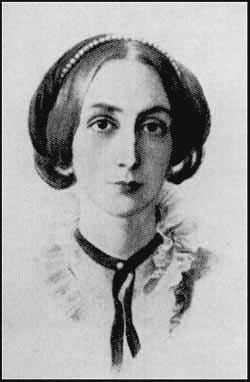 sought-after lady. She had a brief fling with Benjamin Disraeli but eventually married a wealthy industrialist named Josiah John Guest who owned a large ironworks near Cardiff. The marriage was considered a bad one by her friends and family—he was considerably older than she and, even worse, he was “in trade” but there must have been something between them for in 15 years of marriage she gave birth to 5 sons and 5 daughters. She was a woman of wide-ranging intellect, learning several foreign languages during her confinements and took an active role in her husband's business affairs. She organized schools for her husbands’ workers and translated and published a three-volume edition of the classic Welsh mythical cycle, the Mabinogion.
sought-after lady. She had a brief fling with Benjamin Disraeli but eventually married a wealthy industrialist named Josiah John Guest who owned a large ironworks near Cardiff. The marriage was considered a bad one by her friends and family—he was considerably older than she and, even worse, he was “in trade” but there must have been something between them for in 15 years of marriage she gave birth to 5 sons and 5 daughters. She was a woman of wide-ranging intellect, learning several foreign languages during her confinements and took an active role in her husband's business affairs. She organized schools for her husbands’ workers and translated and published a three-volume edition of the classic Welsh mythical cycle, the Mabinogion.
The cousins became very close and it is strongly suspected that they may have been in love if not actually lovers— Layard was always discreet in his dealings with ladies, whether in England or in Middle East. She was supervising a substantial rebuilding of her home at Canford Manor and Layard gave her some reliefs to help with the decoration— one was recently rediscovered in a public school, covered with a thick coat of plaster. She gave him a great deal of encouragement in his work and pressed him to complete his account of his discoveries and, when that was done, persuaded John Murray to publish a scholarly edition of his drawings. Nineveh and Its Remains came out in 1849 and The Monuments of Nineveh a year later.
Layard spent most of 1848 working on his popular account, living with his mother in Cheltenham. He resigned his place on the Boundary Commission in September of that year. At about the same 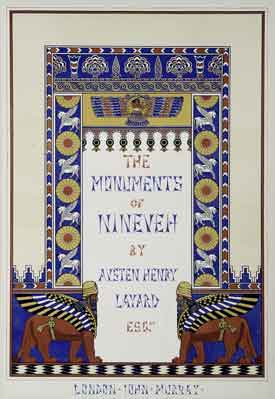 time, the boxes containing the bulk of his excavated material finally arrived in London—having already been displayed in Bombay where they had spent several months awaiting shipment. But when he unpacked them he found that they had been carelessly packed and most of them had been broken. The documentation, showing their provenance was all mixed up and many of the smaller objects had entirely disappeared.
time, the boxes containing the bulk of his excavated material finally arrived in London—having already been displayed in Bombay where they had spent several months awaiting shipment. But when he unpacked them he found that they had been carelessly packed and most of them had been broken. The documentation, showing their provenance was all mixed up and many of the smaller objects had entirely disappeared.
In December, he decided to head back to Istanbul to take up his duties as a member of Canning's embassy staff-a situation which neither man viewed with much relish but early in 1849 Nineveh and its Remains was published and became an instant best-seller. Praise rained down on Layard from all quarters-the president of the Royal Asiatic Society call the book 'the greatest achievement of our time' and even Uncle Benjamin was impressed. Interest in renewed excavations in Iraq, at Küyünjik in particular, was strong and the Museum agreed to finance at least two more seasons (but for the niggardly sum of £3000 in total). This time he was to have an artist, Frederick C. Cooper, and the services of an assistant, Hormuzd Rassam as well as a doctor, Humphrey Sandwith. However, one thing that was a matter of considerable concern to Layard was the lack of a new firman from the Turkish authorities. For political reasons, Canning was reluctant to pursue the matter.
Excavations at Nineveh
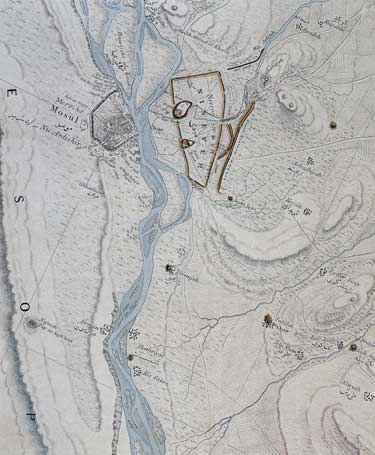
Map of Nineveh and environs by Captain Felix Jones
Soon after his arrival in Mosul, he took a tour of Küyünjik across the river where his friend Henry Ross had been conducting small operations over the past couple of years. The site of ancient Nineveh lies just across the Tigris, at the point where the Khosr River flows into it. The ruined line of its walls could still be discerned, enclosing a trapezoidal area containing two substantial mounds:
1. Küyünjik, the main Acropolis, is an oval (ca. 950 x 500 metres) roughly 30 metres high 2. Nebi Yunus (“the Tomb of Jonah”) is smaller and presumed to have been the Arsenal |
Botta had conducted soundings Küyünjik in 1842 but in areas that were badly disturbed and unproductive. So the following spring he abandoned all activity there and transferred his attentions to Khorsabad about 20 kilometres to the north. Layard had began excavating on the site in 1847, 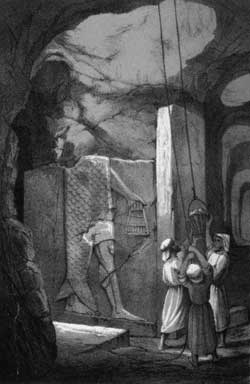 just before his return to England, and work had continued in his absence under the direction of Henry Ross and Christian Rassam.
just before his return to England, and work had continued in his absence under the direction of Henry Ross and Christian Rassam.
The depth of deposit at the site meant that the practice of excavating by means of open trenches was impractical and Rassam’s man on the spot, Fat Toma, devised a new technique to get the remains. His method was simple—he would have his workers sink a shaft in a likely area and then tunnel along laterally (left) until they ran into a wall. Then it was a simple matter of following the wall through doorways, from room to room until the whole complex was revealed. Unfortunately, like most buildings in Mesopotamia, Assyrian palaces were largely made out of sun-dried mudbrick—a material which is very difficult for the untrained eye to recognize—and, if there were no carved stone slabs, the workmen often bored right through many walls without even realizing they had done so. It also meant that the centre of the room was unexcavated.
The remains discovered so far were in the south-western part of the mound and formed part of another palace complex—Layard speculated that it may have belonged to Sennacherib (correctly, as it turned out).
When he visited the site, Layard saw rooms of newly uncovered reliefs and was struck by how different they appeared to those he had found at Nimrud—more like the examples from Khorsabad. The sculptors covered the entire slab with carvings, rather than dividing it into two registers, and there was much more attention to background detail as well as an attempt to convey a sort of perspective. Layard got the impression that the reliefs in a particular room were intended to convey a single story—generally a military campaign. Great care was taken to show the local terrain-the mountains of western Iran; the marshes of southern Mesopotamia; and the orchards 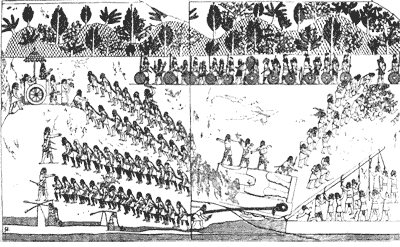 and vineyards of the Levant—so that the viewer could easily identify the country involved. As was the case at Nimrud and Khorsabad, they were badly damaged by fire making them very brittle and, in many cases, only the lower portion survived. This made it impossible to move them so they were left in situ and then the room was backfilled. In most cases, the drawings made by Layard or Cooper are the only record we have of them.
and vineyards of the Levant—so that the viewer could easily identify the country involved. As was the case at Nimrud and Khorsabad, they were badly damaged by fire making them very brittle and, in many cases, only the lower portion survived. This made it impossible to move them so they were left in situ and then the room was backfilled. In most cases, the drawings made by Layard or Cooper are the only record we have of them.
Of particular interest were the scenes found in one of the courtyards showing the quarrying and transportation of one of the colossal winged bull figures which guarded many of the doorways in the palace. They were apparently roughed out at the quarry and then dragged down to the river on sledges where they were loaded onto keleks and floated to the site of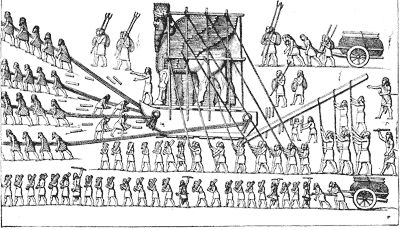 the palace. Here they received their final dressing before being dragged into their final position. The methods were virtually identical to those used by Botta and Layard when they removed them and shipped them back to Europe.
the palace. Here they received their final dressing before being dragged into their final position. The methods were virtually identical to those used by Botta and Layard when they removed them and shipped them back to Europe.
He organized a dozen or so teams of workers-—about one hundred men altogether—to extend the excavations of the South West Palace at Küyünjik while he and Hormuzd Rassam went to Nimrud to plan a resumption of activity. Layard’s plan was to uncover more of the North West Palace and to explore the area around the “Pyramidal Mound” to the north. While surveying the site he came across none other than Henry Rawlinson, asleep at the bottom of one of the old trenches, wrapped in a rug. It was not a very happy meeting—Rawlinson was sick with the fever and clearly exhausted. He was not particularly interested in the architecture and was somewhat condescending about the art—all he seemed to be interested in were the texts. But thanks to his own efforts and those of an Irish parson named Edward Hinkes, it was now possible to read some of the simpler inscriptions with some confidence making it possible to determine which king built the various structures and the order in which they reigned.
Layard spent most of the following months travelling back and forth from one site to the other, supervising operations at both. At Nineveh, he located an imposing doorway flanked by a monumental façade, with enormous winged bulls and ‘Gilgamesh’ figures, similar to one found by Botta at Khorsabad. This was the entrance to the Throne Room, located on the western side of a large courtyard. At Nimrud, meanwhile, he was dealing with the mass of material, including
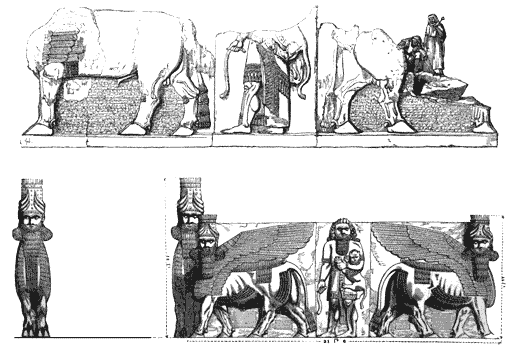
Throne Room Facade at Nineveh as recovered by Layard (above) compared to that at Khorsabad (below)
metalwork, glass vessels and ivory furniture, that had emerged from a well in the southern part of the North West Palace. The ‘pyramid’ turned out to be a type of stepped tower known as a ziggurat. Digging straight into it, he uncovered a long, low gallery (30 x 2 metres) which had evidently been broken into some time in the past, presumably by robbers. Its contents and function remain a mystery.
He found himself under a good deal of strain during this period. Money was running low and he became embroiled in an ongoing feud with some of the directors of the British Museum, his sponsors. He had powerful friends in England who were campaigning through the newspapers for increased funds to be made available to him. Of course the Museum found this all profoundly embarrassing and blamed Layard. There were also problems locally where his relationship with one of his guests scandalized some members of the European community. Captain Stewart Rolland and his wife Charlotte were travelling through the Iraq and stayed with Layard for a time. Captain Rolland was utterly charmed by his host and very supportive of his efforts but was much more interested in hunting than archaeology. Charlotte, on the other hand, was very keen on the subject and through herself enthusiastically into the work at Küyünjik. She was a real beauty, always a plus with Layard, and the two of them had a free and easy relationship that met with strong disapproval from the missionary community.
His work was also hampered by the unsettled state of affairs in the region where Bedouin tribes were allowed to raid virtually unhindered. Layard witnessed such a raid at the village near Nimrud:
One morning, I was suddenly disturbed by the reports of firearms, mingled with the shouts of men and the shrieks of women. Issuing, immediately from the house, I found the open space behind it a scene of wild excitement and confusion. Horsemen, galloping in all directions and singing their war song, were driving before them with their long spears the cattle and sheep of the inhabitants of the village. The men were firing at the invaders; the women, armed with tent poles and pitchforks, and filling the air with their shrill screams, were trying to rescue the animals. The horsemen of the Arab tribe of Tai had taken advantage of a thick mist hanging over the Jaif, to cross the Zab early in the morning, and to fall upon us before we were aware of their approach. No time was to be lost to prevent bloodshed, and all its disagreeable consequences. A horse was soon ready, and I rode towards the one who appeared to be the chief of the attacking party. Although his features were concealed by the keffieh closely drawn over the lower part of his flee, after the Bedouin fashion in war, he had been recognised as Saleh, the brother of the Howar, the Sheikh of the Tai. He saluted me as 1 drew near, and we rode along side by side, whilst his followers were driving before them the cattle of the villagers. Directing Hormuzd to keep back the Shemutti, I asked the chief to restore the plundered property. Fortunately, hitherto only one man of the attacking party had been seriously wounded. The expedition was chiefly directed against the Jebours, who some days before had carried off a large number of the camels of the Tai. I promised to do my best to recover them. At length Saleh, for my sake, as he said, consented to restore all that had been taken, and the inhabitants of Nimroud were called upon to claim each his own property. As we approached the ruins, for the discussion had been carried on as we rode from the village, my Jebour workmen, who had by this time heard of the affray, were preparing to meet the enemy. Some had ascended to the top of the high conical mound, where they had collected stones and bricks ready to hurl against the Tai should they attempt to follow them. Thus probably assembled on this very mound, which Xenophon calls a pyramid, the people of Larissa when the ten thousand Greeks approached their ruined city. Others advanced towards us, stripped to their waists, brandishing their swords and short spears in defiance, and shouting their war cry. It was with difficulty that, with the assistance of Hormuzd, I was able to check this display of valour, and prevent them from renewing the engagement. The men and women of the village were still following the retreating horsemen, clamouring for various articles, such as cloaks and handkerchiefs, not yet restored. In the midst of the crowd of wranglers, a hare suddenly sprang from her form and darted over the plain. My greyhound, who had followed me from the house, immediately pursued her. This was too much for the Arabs; their love of the chase overcame even their propensity for appropriating other people's property; cattle, cloaks, swords, and keffiehs were abandoned to their respective claimants, and the whole band of marauders joined wildly in the pursuit. Before we had reached the game we were far distant from Nimroud. I seized the opportunity to conclude the truce, and Saleh with his followers rode slowly back towards the ford of the Zab to seek his brother's tents. I promised to visit the Howar in two or three days, and we parted with mutual assurances of friendship
An Expedition to the Khabur
Whenever he could get away, Layard liked to tour some of the other important sites in the region and set his workmen to open trenches at a number of these. In the Spring of 1850, word reached him of the discovery of two colossal bull statues at a site in the Khabur region. The Khabur River is the last tributary of the Euphrates before it joins the Tigris near Basra. Its headwaters are in northern Syria, a region largely unexplored by Westerners but known to be rich in archaeological sites. He decided to organize a large expedition and set out in March of that year under the protection of one of the sheikhs of the Shammar, the predominant tribe in the region.
Travelling across the Jebel Sinjar, Layard's caravan passed through a landscape dominated by the ruined mounds of ancient tells:
As the evening crept on, I watched from the highest mound the sun as it gradually sank in unclouded splendour below the sea-like expanse before me. On all sides, as far as the eye could reach, rose the grass-covered heaps marking the site of ancient habitations. The great tide of civilisation had long since ebbed, leaving, these scattered wrecks on the solitary shore. Are those waters to flow again, bearing back the seeds of knowledge and of wealth that they have wafted to the West ? We wanderers were seeking what they had left behind, as children gather up the coloured shells on the deserted sands. At my feet there was a busy. scene, making more lonely the unbroken solitude which reigned in the vast plain around, where the only thing having life or motion were the shadows of the lofty mounds as they lengthened before the declining sun. Above three years before when, watching the approach of night from the old castle of Tel Afar, I had counted nearly one hundred ruins, now, when in the midst of them, no less than double that number were seen from Tel Jemal.
The Khabur region was just as unsettled as the rest of Iraq—tribal feuds were endemic and attacks on caravans were quite common. Layard’s group ran into a band of Bedouins who had just plundered a Turkish government caravan:
We crossed, daring the following evening, a beautiful plain covered with sweet smelling flowers and aromatic herbs, and abounding in gazelles, hares, and bustards. We reached in about two hours the encampments, whose smoke we had seen during the preceding evening. They belonged to Bedouins of the Hamoud branch of the Shammar. The tents were pitched closely together in groups, as if the owners feared danger. We alighted at some, distance from them to avoid entering them as guests. The chiefs soon came out to us, bringing camels' milk and bread. From them we learnt that they had lately plundered, on the high road between Mosul and Mardin, a caravan conveying, amongst other valuable loads, a large amount of government treasure. The Turkish authorities had called upon Ferhan, as responsible chief of the Shammar, to restore the money, threatening, in case of refusal, an expedition against the whole tribe. The Hamoud, unwilling to part with their booty, and fearing lest the rest of the Shammar might compel them to do so in order to avoid a war, were now retreating towards the north, and, being strong in horsemen, had openly defied Ferhan. They had been joined by many families from the Assaiyah, who had crossed the Euphrates, and united with the Aneyza on account of a blood feud with the Nejm. The Hamoud are notorious for treachery and cruelty, and certainly the looks of those who gathered round us, many of them grotesquely attired in the plundered garments of the slaughtered Turkish soldiery, did not belie their reputation. They fingered every article of dress we had on, to learn its texture and value.
When he arrived at Arban, where the bulls were found, he was greeted by the sheikh, Mohammed Emin,
The tents of the chief were pitched under the ruins of Arban, and on the right or northern bank of the river, which was not at this time fordable. As we drew near to them, after a ride of nearly two hours, Mohammed Emin pointed in triumph to the sculptures, which were the principal objects of my visit. They stood a little above the water's edge, at the base of a mound of considerable size. We had passed several tells and the double banks of ancient canals, showing that we were still amidst the remains of ancient civilisation.
The ancient site was cut by the river and the bulls had been partially exposed as the result of a landslide and so excavating them was going to be tricky. They were smaller and, to Layard, seemed cruder than those found at the major palaces. The inscription on them said that they belonged to the “palace of so-and-so” but the name was unfamiliar.
We now know that they were set up by the local governor, a man named Mušezib-Ninurta, in about 800 BC. Layard’s workers found no walls in association with them nor with another pair found in the course of their excavations. Of course there were walls but, because they were made of mud-brick and had not been lined with stone slabs like those at Nineveh and Nimrud, they went unrecognized. In all, Layard was somewhat disappointed and gave up on further excavations.
When they returned to Mosul, it was evident that Layard's relationships with some of the Europeans were becoming strained. This was particularly so with Captain Rolland who clearly was jealous of the relationship between Layard and his wife. Layard described Rolland as, “one of the most selfish, ill-bred, unfeeling and conceited men I ever met” and it was clear that she was being abused, verbally if not physically. The captain’s mood swings were becoming increasingly violent and were having a profound effect on Charlotte. Layard's solution was to give her a room in his own house—perhaps not the most prudent move. Things reached a head when the party was returning to Mosul from Nimrud. Rolland became abusive and was particularly insulting to Layard, who chose not to respond. He then dragged his wife off to their tent.
A few moments afterwards I heard violent screams proceeding from his tent, which was left completely open on two sides. One of my servants running in at the same time cried out that Mr. Rolland had thrown his wife to the ground and was attempting to murder her. I had only one course to pursue and calling some people we separated them and secured him. He was in a most violent state-uttering abuse which I need not repeat and calling for his arms—because I had dared to interfere between him and his wife.
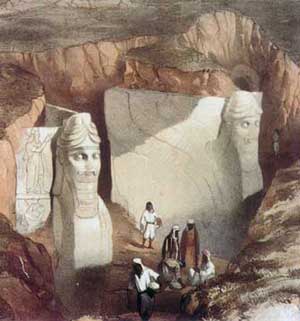 In the end, the captain was released and wrote a formal letter of apology absolving Layard of any impropriety. The Rollands were asked to leave and headed back to England.
In the end, the captain was released and wrote a formal letter of apology absolving Layard of any impropriety. The Rollands were asked to leave and headed back to England.
While Layard had been off in the Khabur country, work had continued around the ziggurat at Nimrud and two temple complexes to the east of it had been reached by tunnelling. The larger building had two entrances, one of them guarded by colossal human-headed winged lions while the other was formed of large relief blocks. A particularly fine, arched stela of the king stood to one side of the second doorway along with a small stone altar. The interior of the temple, which we now know was dedicated to the god Ninurta, was badly damaged by fire and produced little in the way of artefacts— although there was a large slab bearing a long inscription. 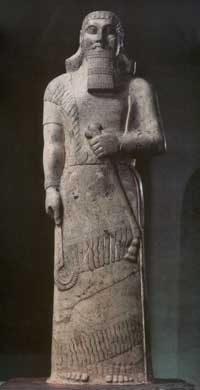 The smaller temple, dedicated to Ištar-belit-mati (“Ištar, mistress of all lands”), was guarded by a pair of large naturalistic lions and contained a superb statue of the king (right) who built the North West Palace, Aššur-nasirpal II.
The smaller temple, dedicated to Ištar-belit-mati (“Ištar, mistress of all lands”), was guarded by a pair of large naturalistic lions and contained a superb statue of the king (right) who built the North West Palace, Aššur-nasirpal II.
All of this was reported to Layard by Matilda Rassam, wife of the British Consul, when he returned to Mosul. However, she also had to report torrential rains had flooded the whole area, right up to the base of the mound, and that one of the colossal lions had been broken when the pair of them were being loaded onto rafts for shipment. A week later, he received a letter from Captain Felix Jones, who commanded a steamship on the river, that one of the two rafts had been swept into an enormous swamp created by a breach in the Tigris bank. Fortunately, it was possible to manoeuvre the steamship into the swamp and transfer the cases of smaller reliefs and objects. Shifting the lion proved to be a very difficult proposition but, eventually, it was rescued too.
At Küyünjik too, the work was proceeding most satisfactorily and more rooms of the South West Palace had been uncovered, mainly through tunnelling. One long corridor was decorated with reliefs showing servants carrying platters of choice delicacies (including dried locusts) for some banquet al fresco. Another set of rooms, guarded by figures that appeared to be part man and part fish, contained over twenty thousand cuneiform documents-the archives of the palace.
They worked into the summer, although by July conditions had become unbearable, with temperatures often reaching 50° C. Cooper and Dr. Sandwith were both suffering from heat exhaustion and had to be sent into the hills to recover. Layard and Hormuzd Rassam each suffered recurrent bouts of malaria. So in July, Layard suspended operations and packed up the first shipment of sculptures from Küyünjik. Then the two of them caught up with Cooper and Sandwith and the whole party headed for Lake Van, high up in the mountains. Unfortunately, the condition of the doctor and the artist continued to worsen and they had to be sent to Constantinople.
While Layard was away, work progressed rapidly at Küyünjik and several more rooms had been uncovered, centred around a large courtyard. The reliefs in this part of the palace were predominantly military in theme, the ones in the courtyard depicting a campaign in Babylonia (the twin rivers and the date palms give away the locale). On the west side of the courtyard was a monumental doorway, guarded by a pair of winged bulls. The doorway led through a pair of broad antechambers to a small room at the back (XXXVI). Evidently it was a room of some importance since each doorway leading to it was flanked by a similar pair of bulls. The reliefs in this room depicted the siege and capture of a town in the Levant (the landscape depicts hills covered with vineyards). We now know that the town in question was Lachish, one of the garrison towns of the
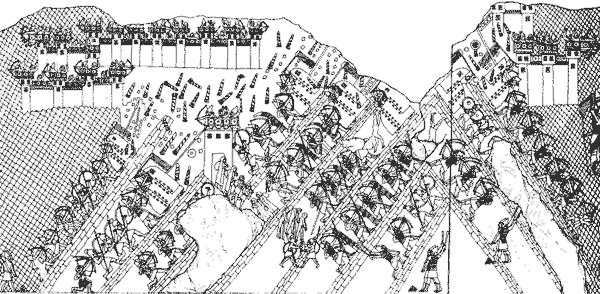
The Storming of Lachish from Sennacherib's Palace at Nineveh
Kingdom of Judah whose capture by Sennacherib is described in terrifying detail in the Old Testament. The whole sequence of events, from the arrival of the Assyrian army to the deportation of the survivors is shown in a single tableau. The centrepiece of the composition, placed opposite the doorway, was the storming of the town. Under the covering fire of archers and slingers, the Assyrian heavy infantry are shown advancing up a siege ramp, pushing battering rams up to the town walls. The defenders, meanwhile, are frantically throwing bricks onto the heads of the attackers and trying to destroy their siege engines with torches. Recent excavations at the actual site of Lachish have confirmed many of the details of the composition, such as the ramp and the double walls. The reliefs now hold pride of place in the Assyrian collection of the British Museum.
Departure
By October, Layard stopped work at Nineveh and had organized another large shipment of objects for the British Museum. He had long since reached the decision that this would be his final season in Iraq and applied for permission to return home the following Spring in order to catalogue his finds and write a final report. In the meantime, he intended to travel south by raft to Babylonia where he could explore its ancient mounds in the cooler winter months. The countryside was crawling with bandits, however, and one of the rafts carrying Layard's finds had already been attacked. Layard himself travelled under the protection one of the local sheikhs and reached Baghdad with little incident.
Baghdad was a particularly dangerous place to be in the 1850's. Not twenty years had passed since the city had been utterly devastated by an outbreak of the plague. People had died in their tens of thousands—out of a total population of perhaps 150,000 or so. The situation was made infinitely worse when the Tigris burst its banks and flooded the city. By the time of Layard's second visit, its population had scarcely reached a third of its previous total. The countryside was swarming with bandits and it was very dangerous to be outside the walls. It wasn't much safer inside the walls. The sanitation system had completely broken down after years of neglect and epidemics were a regular occurrence. Under the circumstances, Layard stuck fairly close to the city until he reached some sort of understanding with the local authorities but in December he was able to start work at Hillah, the site of ancient Babylon. The results were less fruitful than he had hoped because of the overburden of Hellenistic remains and he decided it would be a waste of both time and money to continue. In January 1851, he tried his luck further south at the site of Nippur but was disappointed here too and eventually returned to Baghdad suffering from recurrent bouts of malaria and complete exhaustion.
Despite his condition and the fact that, after having spent the better part of a decade in the Near East, he had clearly lost his enthusiasm, Rawlinson and others tried to urge him to continue and had raised private funds for the purpose. But Layard was determined to return home and could not be swayed. He returned to Mosul where he handed over responsibility for continued excavation at Küyünjik to a young man named Bell who had come to replace Cooper as artist. He supervised the loading of the last consignment of cases and wrote his final account of the excavations for the British Museum. As he took one last tour through its rooms and corridors, he had every reason to be proud of himself:
Such were the discoveries in the ruined palace of Sennacherib at the time of my departure for Europe. In this magnificent edifice I had opened no less than seventy-one halls, chambers and passages, whose walls, almost without an exception, had been panelled with slabs of sculptured alabaster recording the wars, the triumphs, and the great deeds of the Assyrian king. By rough calculation, about 9880 feet, or nearly two miles, of reliefs, with twenty-seven portals, formed by colossal winced bull and lion-sphinxes, were uncovered in that part alone of the build explored during my researches. The greatest length of the excavations was about 720 feet the greatest breadth about 600 feet. The pavement of the chambers was from 20 to 35 feet below the surface of the mound.
A glance at the general plan will show that only part of the palace has been explored, and that much still remains underground of this enormous structure. Since my return to Europe other rooms and sculptures have been discovered. Both to the north and to the east of the ruins comprised in the plan, I had found traces of chambers, and the fragments of has-reliefs. The excavations having been carried to the very edge of the mound to the south and the west, nothing, of course, remains to be discovered on those sides. How far any of the unexplored part of the palace may still he preserved, it is of course impossible to conjecture.
Epilogue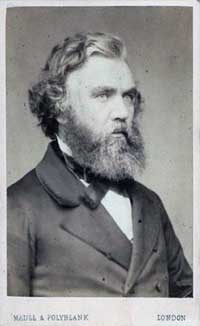
Layard went on to have a long and colourful career, serving as an MP until 1869 and becoming a highly respected and effective politician-in 1861 he became Vice-Minister for Foreign Affairs. In 1855 he had been one of the founders of the Ottoman Bank and became its chairman of the board—from then on, he was financially independent. He spent his holidays in Italy and where he enthusiastically pursued his passion for Italian art-he headed the Arundel Society dedicated to its protection and took a special interest in the fate of Venice. After the 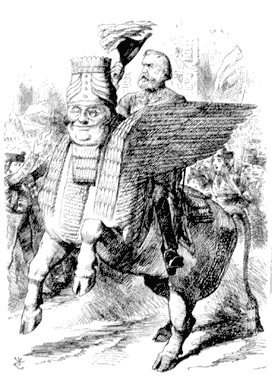 death of her husband in 1853, Charlotte Guest decided to marry the her son's teacher, a man 14 years younger than herself—Layard did not approve and there followed a rift between the two. After a few years, the pair seem to have patched things up but they fell out again in 1869 when the 55 year-old Layard proposed marriage to her 25 year-old daughter, Enid.
death of her husband in 1853, Charlotte Guest decided to marry the her son's teacher, a man 14 years younger than herself—Layard did not approve and there followed a rift between the two. After a few years, the pair seem to have patched things up but they fell out again in 1869 when the 55 year-old Layard proposed marriage to her 25 year-old daughter, Enid.
He served as ambassador to Spain from 1869-77 and then as ambassador to Turkey, thus taking over the post that Canning had held all those years ago.
After his retirement in 1884, he moved to Venice where he and Enid shared a palazzo on the Grand Canal. He fell ill there in 1894 and returned to England where he died on July 5. After his death, his wife presented his papers to the British Library—but was very careful to remove all of the correspondence between Layard and her mother.
Suggested Reading
| Larsen, Mögens T. | (1996) | The Conquest of Assyria |
| Layard, A. H. | (1849) | The Monuments of Nineveh |
| (1853) | Discoveries among the ruins of Nineveh and Babylon | |
| (1867) | Nineveh and Babylon A narrative of a second expedition to Assyria, during the years 1849, 1850, and 1851 | |
| (1860) | Inscriptions in the Cuneiform Character, from Assyrian monuments, discovered by A. H. Layard, D.C.L. | |
| (1887) | Early Adventures in Persia, Susiana, and Babylonia | |
| (1894) | A Handbook of Rome and its Environs | |
| (1903) | Autobiography and Letters from his childhood until his appointment as H.M. Ambassador at Madrid | |
| Lloyd, Seton | (1981) | Foundations in the Dust |

